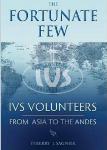IVS and the Foundation of the Peace Corps, Part 2
The Fortunate Few details some of the organization of the International Voluntary Services (IVS) and its links to the Peace Corps, but the majority of the 370 page book is spent telling the stories of individual volunteers and their tours. And they have, not unlike PCVs, stories to tell.
In reading the book, I was particularly drawn to the stories of the PCVs who were also in IVS, and especially those volunteers who served in Ethiopia as PCVs. There were at least six such volunteers to IVS. One name in particular jumped out at me.
Gary L. Daves (Ethiopia 1964-66), IVS/VN 67-73 (Captured in Hue, South Vietnam by the Viet Cong in 1968 and spent next 5 years in a Hanoi, North Vietnam prison.
Now here was a story I had never heard.
According to the accounts in The Fortunate Few, IVS’s involvement in Vietnam began in 1957. Noffsinger had come to believe that “IVS’s involvement in Vietnam would be beneficial to the country, and the first batch of volunteers arrived early the following year. They were mostly recent graduates of agricultural programs.
In the early 1960s, the role of IVS volunteers expanded to education, in urban and rural settings, for both men and women. “At its peak in 1967,” writes Sagnier, “IVS had over 160 volunteers in Vietnam and by the time it departed in mid-1971, had fielded approximately 400 volunteers in the war-torn land.”
In this second decade (1963-1972) of IVS was when most of the RPCVs went to Vietnam. In telling the story of IVS, the second decade takes up 192 pages of the 370 book and the 50 years of IVS. It was also when three IVS volunteers were captured by North Vietnam. Sandra Johnson, Marc Cayer and RPCV Daves were all taken prison in Hue by NVA soldiers during the Tet offensive of 1968. Johnson was freed March 31, 1968; Dave and Cayer remained captives until March 27, 1973.
Marc Cayer was a French-speaking Canadian national who arrived in Vietnam in October of 1967. In The Fortunate Few he tells how he and Gary Daves were captured in Hue at the beginning of January, 1968 is told.
Marc writes: “On January 31, the VC attacked Hue and Gary Daves and I were surrounded. What to do? We just had to wait. There was no food, no light, just a lot of noise outside. On February 3 at about three o’clock in the afternoon the VC knocked on the door and we had to surrender.”
It was the beginning of five years and ten days as a prisoner of war for these IVS volunteers.
They were taken to a small house outside the city. “I did not have pants-just underwear-and Gary gave me a pair of his pants. Then, we were taken to the mountains, a long day of walking with our elbows tied tight behind our backs. About a week later, we were joined by Sandra Johnson who, just before our capture, had invited me to go with her to a party.”
Soon after that, Daves, Cayer and Johnson began walking toward Laos. For 13 days they slept on the ground with just a plastic tarp to shield them from the morning rain.
Next they stayed at a camp near Laos for four days. While there, American planes dropped bombs and Cayer was badly wounded in his left foot.
A few days later they were taken by truck for a nine-day journey on the Ho Chi Minh trail. “It was a terrible experience,” writes Cayer, “rough roads, bombings, no sleep and little food.”
This was the beginning of Cayer and Daves prison days. No more is written about Daves, but Cayer who was the only Canadian prison of war in Vietnam, ended up writing a book about his prison experiences entitled Prisoner in Vietnam, Washington, D.C., Asia Resource Center, 1990.
Cayer sums up his experiences as a prisoner, writing: “On January 27, 1973, they told us that a peace agreement would be signed the following day, and that our entire group would go to Hanoi. I was in the Hanoi Hilton by the end of the afternoon. I stayed with two Germans prisoners, a boy and a girl, for 10 days. They were originally in a group of five that was captured not far from Danang. They walked sixty days towards the north and three of them died on the trail. I was with a group of about forty-five prisoners when it was time for me to get released. What a nice day it was!”
Postscript
Cayer retired from government service in 1997, and resides just outside Quebec City, Canada. In 1988 he and his wife returned to visit North Vietnam for 11 days.
•
Click for Part 1 and Part 3 of this article.
.
.
There is a chill in the goodness emanating in this tale.
John, can you give us a complete citation on this title?
The complete title, Patricia, as stated in Part 1 is The Fortunate Few IVS Volunteers From Asia to the Andes written by Thierry J. Sagnier. The book was published by the NCNM Press of Portland, Oregon. It was published in 2015. The ISBN 10-digit number is 0-9771435-7-0.
The Library of Congress Control Number: 2015909683
I just recently got the book and am still